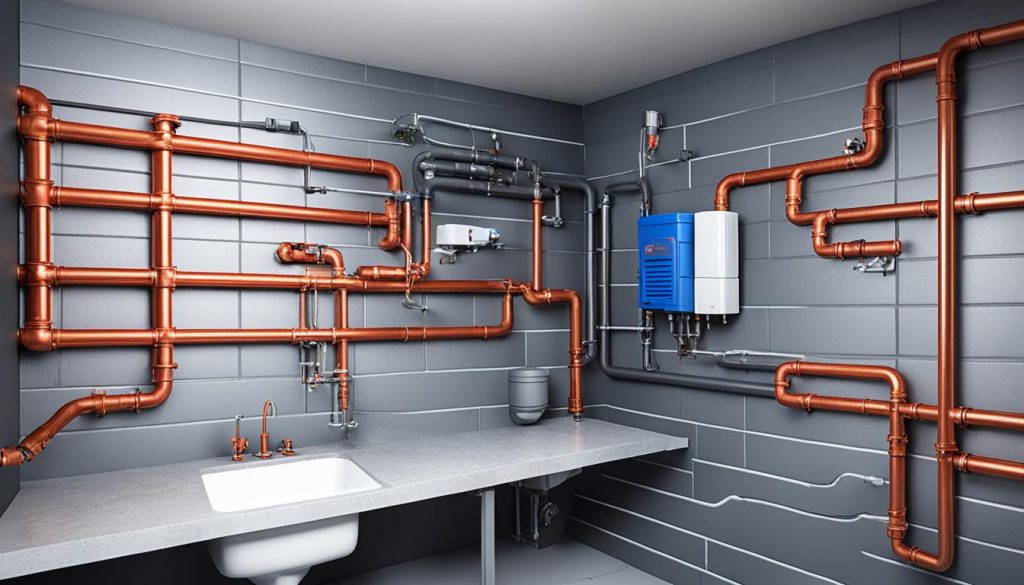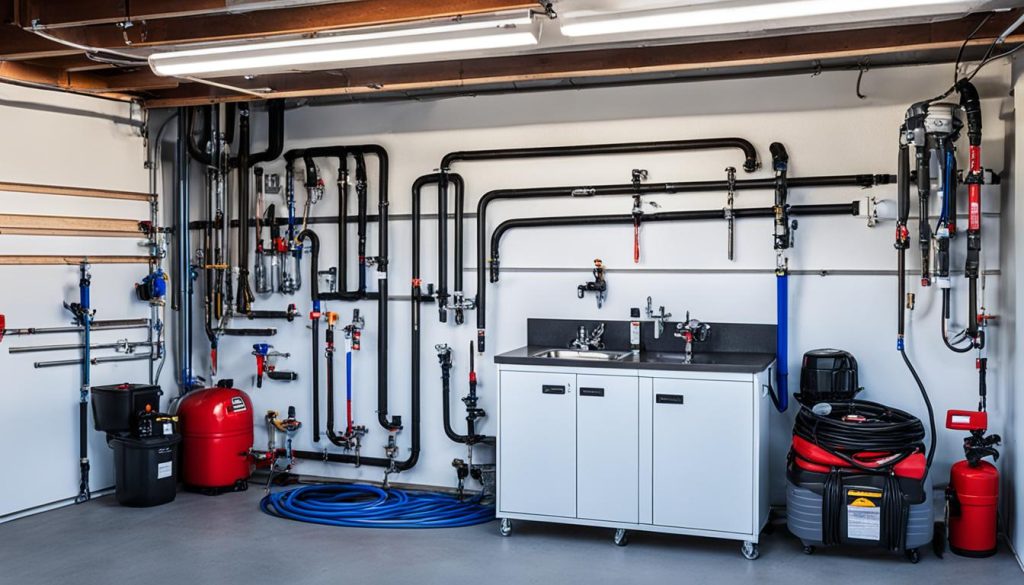Adding Plumbing to a Garage: Expert Tips
Did you know that adding plumbing to a garage can greatly enhance its functionality and value? Whether you’re looking to convert your garage into a workshop, a home office, or even a livable space like an accessory dwelling unit (ADU), incorporating plumbing is a smart investment.
However, there are several factors that can impact the cost and process of adding plumbing to a garage. From material costs to the layout of your home and garage, careful planning and expert guidance are crucial for a successful installation.
In this article, I will share expert tips and insights on how to add plumbing to a garage, factors affecting the cost, the necessary steps, and the benefits of incorporating plumbing into your garage space. Whether you’re considering a simple sink installation or a full bathroom addition, this guide will provide you with the information you need to make informed decisions and achieve your desired results.
Key Takeaways:
- Adding plumbing to a garage can greatly enhance its functionality and value.
- Factors such as material costs, garage foundation, and the layout of your house and garage can impact the cost of adding plumbing.
- Proper planning and expert guidance are essential for a successful installation process.
- Adding plumbing to a garage offers benefits such as increased convenience, improved drainage, and potentially higher home value.
- Adding a bathroom to a garage requires careful consideration of structural, plumbing, and electrical requirements, as well as compliance with local regulations.
Factors Affecting the Cost of Adding Plumbing to a Garage
When considering the cost of adding plumbing to a garage, it’s important to take into account several factors that can influence the overall expense. These factors include:
- The material cost of pipes and valves: The type and quality of plumbing materials used can greatly impact the cost. Opting for high-quality, durable materials may be more expensive initially but can save you money in the long run.
- Drilling through concrete garage foundations: If your garage has a concrete foundation, drilling through it to install plumbing may require specialized equipment and expertise, increasing the cost of the project.
- Depth of the main sewer line: The depth at which the main sewer line runs can affect the complexity and cost of connecting the garage plumbing to the existing sewer system.
- Insulation and ventilation in the garage: If your garage is not properly insulated or lacks proper ventilation, additional work may be needed to ensure the plumbing system functions efficiently, which can increase the overall cost.
- Distance between the house and garage: The distance between the house and garage can impact the length of piping required, which can affect the cost of materials and labor.
Considering these factors when estimating the cost of adding plumbing to your garage is essential. To ensure a successful and cost-effective project, it’s recommended to hire experienced garage plumbing contractors who specialize in this type of work. These professionals have the expertise and knowledge to navigate any challenges that may arise and can provide valuable guidance throughout the process.
Steps to Run Plumbing to a Garage
To run plumbing to a garage, there are several important steps that need to be followed. By ensuring proper planning and working with experienced garage plumbing contractors, you can achieve a successful plumbing installation in your garage. Here are the key steps involved:
1. Plan the Connection
Start by identifying the closest part of the existing plumbing in your house to the garage. This will determine where the connection needs to be made. Consider the slope for drainage pipes to ensure proper water flow.
2. Dig Out the Necessary Space
Next, you will need to dig out the necessary space for the new plumbing pipes. Depending on your garage’s construction, this may involve digging into concrete or the ground. It’s essential to make enough room for the pipes and ensure they are properly positioned.
3. Install Fixtures, Plumbing, and Ventilation
Once the space is prepared, a professional plumber will install the necessary fixtures, plumbing, and ventilation to make the system work. The specific requirements will depend on your project’s scope, whether you are converting the garage into an accessory dwelling unit (ADU) or simply adding sinks, faucets, toilets, and a shower.
Working with garage plumbing contractors who specialize in garage plumbing solutions is crucial. They have the expertise needed to ensure that the installation is done correctly and meets all local building codes and regulations.
By following these steps and partnering with the right garage plumbing contractors, you can successfully run plumbing to your garage and enjoy the convenience and functionality it brings.
| Benefits of Running Plumbing to a Garage |
|---|
| Makes the garage more functional and versatile |
| Allows for easy access to water for various purposes |
| Enhances convenience, especially for car maintenance or outdoor activities |
| Prevents water pooling and flooding in the garage |
| Increases the overall value of the home |
Benefits of Adding Plumbing to a Garage
Adding plumbing to a garage can offer several benefits. Whether you’re using the garage as a workshop, a home gym, or a recreational space, having access to running water can greatly enhance its functionality and convenience. Here are some key advantages of investing in garage plumbing services:
1. Increased Functionality
By adding plumbing to your garage, you can incorporate a sink or multiple sinks that serve various purposes. This allows you to easily clean tools, equipment, and other items without having to bring them into your home. Having a dedicated space for washing up can save time and make your garage more efficient.
2. Convenience and Comfort
Installing a utility sink or a half bath in your garage can provide convenience and comfort, especially if you spend a significant amount of time in the space. Whether you’re working on your car, tending to DIY projects, or hosting outdoor gatherings, having access to a sink and a toilet can greatly enhance your experience and make the garage a more enjoyable and functional part of your home.
3. Improved Drainage and Prevention of Flooding
Adding plumbing to a garage allows you to address drainage issues and prevent water pooling or flooding. By installing proper drainage systems, including floor drains and sump pumps, you can effectively manage any water that enters the garage, protecting your possessions and ensuring a dry and safe environment.
4. Increase in Home Value
Investing in garage plumbing solutions can also contribute to an increase in the overall value of your home. The added functionality, convenience, and improved drainage make your garage more appealing to potential buyers. A well-equipped garage with proper plumbing can be seen as an additional feature that sets your property apart from others.
With these benefits in mind, it’s clear that adding plumbing to a garage can be a worthwhile investment. Not only does it enhance the functionality and convenience of the space, but it also offers potential financial returns in the future.
| Benefits | Description |
|---|---|
| Increased Functionality | Adding a sink enables easy cleaning of tools and equipment. |
| Convenience and Comfort | A utility sink or half bath provides convenience and comfort for various activities in the garage. |
| Improved Drainage and Prevention of Flooding | Proper plumbing systems help manage water and prevent flooding in the garage. |
| Increase in Home Value | The added functionality and convenience of garage plumbing can raise the overall value of your home. |
Considerations for Adding a Bathroom to a Garage
Adding a bathroom to your garage can be an exciting project that enhances both the functionality and value of your home. However, it’s important to consider several key factors before diving into the process.
First and foremost, consulting with a licensed general contractor is essential. They will evaluate the existing plumbing and electrical systems in your garage, ensuring that they can support the addition of a bathroom. This step is crucial to avoid any potential issues down the line and ensure a smooth installation process.
Proper ventilation is another critical consideration. A bathroom in a garage requires adequate ventilation to prevent moisture buildup, which can lead to mold and other issues. Your contractor will help you determine the most effective ventilation system for your garage bathroom, ensuring a comfortable and healthy environment.
Lastly, careful planning of the bathroom layout is necessary to comply with building codes and achieve the desired design. Collaborating closely with your contractor will help you navigate these requirements and create a functional and aesthetically pleasing space.
The total cost of adding a bathroom to a garage can vary depending on the complexity of the project, as well as the choice of materials and fixtures. Typically, you can expect to invest between $30,000 and $60,000 for a well-executed garage bathroom addition. To ensure the best results, it’s crucial to work with experienced garage plumbing experts who have a deep understanding of the unique requirements and challenges associated with this type of project.
Source Links
- https://www.alliedreddirooter.com/five-ways-to-add-plumbing-in-your-garage/
- https://simpsonplumbingservices.com/how-to-run-plumbing-to-a-detached-garage/
- https://www.greatbuildz.com/blog/tips-adding-bathroom-garage/
- Investing Wisely: How Windows & Doors in Boost Property Value and Financial Health - April 24, 2025
- The Financial Impact of Personal Injuries: Why Legal Help Matters for Business Owners - April 16, 2025
- The Hidden Financial Costs of Domestic Assault: What Business Owners Need to Know - April 16, 2025













